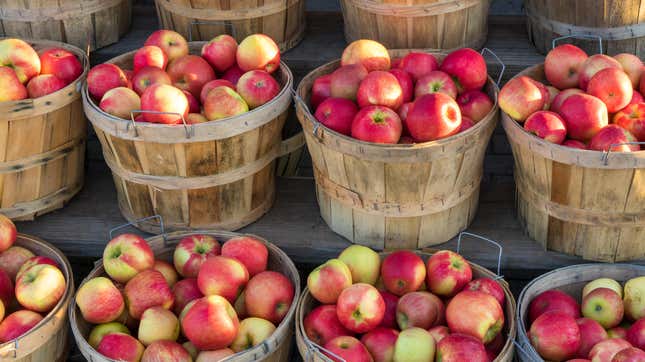
When you call Green Mountain Orchards, a popular pick-your-own-apples destination in Putney, Vermont, the current outgoing message doesn’t boast about which apple varieties are available for picking.
“We managed to scrape up enough to keep our farm store going,” a voice on the other end of the line says, in part, explaining that the orchard’s PYO offering is not available this year. The message goes on to encourage visiting anyway—there are apples for sale, along with cider, cider doughnuts, and pies.
Vermont’s apple shortage, explained
On May 18 of this year, much of Vermont experienced freezing temperatures not typical for that late in the season. Casey Darrow, co-owner of Green Mountain Orchards, told The Takeout this week that the orchard lost 90% of its crop in that freeze. As of early October, the orchard had just crossed the threshold of its 3,000th bushel picked. Typically, a season comprises 50,000 bushels.
“We had a low of 24 degrees, and 28 degrees is where you start to have significant damage,” said Darrow. “It was also below 28 for most of the night. By the time dawn came around, and even after the sun had come up, it was 25, 26 degrees. We were basically panicking.”
A lot of people have asked whether the trees had blossomed earlier this year compared to other years, thus making them more vulnerable to freezing temperatures, but Darrow said that wasn’t the case. They were right on time. The freeze was the outlier and Darrow knew, even in those early hours, that the results were going to be dire.
“Over the next few days, we started to cut open he little fruitlets, and it looked as bad as we thought,” he said. “We cut open a hundred fruitlets from trees in different areas, and every single one was black inside.”
Darrow said that despite the early signs of devastation, the crew waited a good long while into the summer before making a call about whether its pick-your-own operation would be able to run this year. Some varieties of apples looked like they might be okay, albeit small and perhaps misshapen. But as summer went on, it seemed less tenable.
“Pretty late in the summer, we finally just said, ‘No, we can’t open for pick-your-own,’” said Darrow. “We’d sell out in one weekend, we’d have to tell people where the fruit is and isn’t, and they’ll be disappointed because they’re small and misshaped.”
In Vermont, a place where apple picking is a tourist destination, that’s a tough decision to make. Darrow said that on a recent weekend, the orchard’s farm store brought in one-third of the revenue that weekend had brought in the year prior.
“We aren’t getting the crowds,” he said. “We haven’t had a parking problem yet where the parking lot is overflowing. It’s definitely affected people coming out.”
How orchards survive a bad crop
Darrow said that even with crop insurance, it will be impossible to recoup the loss entirely, so the orchard has been tightening its spending, including cutting back on how much labor it invested in for the summer and fall. Winter looms, though, and the work of winter will be exacerbated by the lack of a harvest, not alleviated by it.
The orchard spends the winter pruning the trees, a task that’s integral to ensuring a good crop the following year. Darrow said that because the trees didn’t produce fruit this summer and fall, they put more energy into growing the parts of the tree that will have to be pruned off.
“It’s like a double whammy,” said Darrow, noting that the orchard will need to increase the amount of labor during a winter fed by a dearth of income from a hollowed-out fall. “But we’re going to be okay. I think we’re in a decent position, providing we have a crop next year.”
Other recent crop shortages across the country
The unpredictability of weather, spurred largely by climate change, is affecting crops in various ways. While cold impacted apples in Vermont, heat, and then frost, impacted peaches in the South, particularly in Georgia. Meanwhile, in Wisconsin, this year’s apple crop was diminished by drought.
Darrow said it’s the unpredictability that gives him concern for the future. Although there are some measures an orchard can take to protect its already blossoming crops from freeze, none are particularly practical for a relatively small orchard. One method, for example, involves giant fans called Frost Fans that stir up the air, which on a particularly cold night is often striated. They cost, Darrow said, around $100,000 each, and his orchard would require at least a dozen of them.
“Some orchards bring in helicopters to do the same thing,” he said. “But I wouldn’t even know who to call.”
Though insurance will help him recoup about 25% of what was lost this year, Darrow said he has concerns that as more weather events affect more fruit-growing operations, even that could become untenable.
“One of my concerns is that at some point, insurance companies will say, ‘This isn’t working for us—we keep having these big payouts, we have to triple the premium,’” he said. “My fear is insurance will become less effective for farms. How we are going to protect our ability to produce food? Will that be from the federal government, or what?”
For Darrow, that calls into question how viable his industry, and agriculture at large, can remain if such devastating events began to happen more often.
“If this happened every five years, could a business like ours survive? If not, then we’re in big trouble. And not just us. Agriculture is in big trouble.”